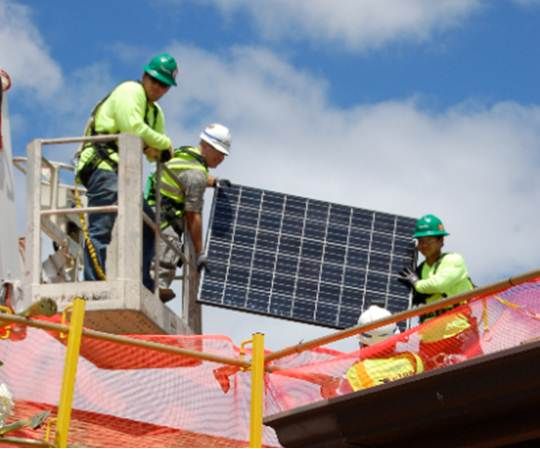Amidst a tough lending climate, two of the nation’s biggest financial institutions have put big money into solar for the U.S. military.
The just-announced new round of the Department of Defense's SolarStrong program will build solar systems on 850 military residences at three Air Force bases with a U.S. Bancorp (USB) and Bank of America Merrill Lynch (BofA ML) financing package put together by SolarCity.
In the newest SolarStrong undertaking, SolarCity will partner with Lend Lease, a global real estate developer, on housing for the Los Angeles Air Force Base (AFB) Tierra Vista community as well as on homes at Peterson AFB and Schriever AFB in Colorado Springs, Colorado.
SolarStrong is part of a program instituted by Congress to bring housing standards on U.S. military bases up to a level worthy of the nation’s fighting forces. The predicted returns to the investors are changing the way lending institutions think about solar.
SolarCity’s five-year SolarStrong program will bring an estimated $1 billion in private sector money into solar for military housing, with BofA ML as a debt participant and USB as a tax equity participant. The program will build an estimated 300 megawatts of solar on some 120,000 military housing units and likely will be the biggest residential solar photovoltaic project in the country.
SolarCity expects the 18,000 panels being deployed in the second phase to generate 6.4 million kilowatt-hours per year, cut the communities’ electricity use by 30 percent to 60 percent, and reduce blackout-threatening peak demand strain on surrounding electricity grids.

The Military Housing Privatization Initiative (MHPI) of 1996, explained SolarCity Solar Development VP Aaron Gillmore, authorized the Department of Defense to draw on private sector investment and capability to speed improvement of military housing.
SolarCity initially approached the Department of Energy (DOE) to guarantee SolarStrong, Gillmore said, because it was so different from other solar developments they didn’t think it would otherwise find financing. It was “a portfolio of projects,” Gillmore said, “really diversified and all over the country, with lots of little systems [and] all kinds of different markets.”
But they thoroughly worked through it with BofA ML, Gillmore said, and when controversy forced the DOE to back out, “Bank of America said, 'We’d still like to close it. We might not be able to have the same interest rate but we can do better than some of the terms DOE gave you.'”
It turned out “every bit as good for us and our customers,” Gillmore added, because the bank really understood the deal and what the risks were.” But, he said, “We then had to go raise tax equity to function with that debt.”
SolarCity’s third-party financing program for solar had, up to then, been largely funded by tax equity investors. Financial institutions and private interests partnered with them on solar projects to offset tax obligations. Partial ownership entitled investors to the 30 percent federal tax credit Congress granted to solar through 2016 as part of the 2008 financial relief package. It also entitled them to solar’s accelerated depreciation tax benefit.
“Within a year, they’re realizing that 30 percent benefit and they realize the accelerated depreciation of these systems over five years,” Gillmore said. “And they get a portion of the cash flow we get from a power purchase agreement with the customer.”
Though down from the high teens that internal return rates (IRRs) earned for SolarCity’s tax equity partners during the financial crisis when the market was slow, Gillmore said, tax equity investments like the one USB has committed to in SolarStrong still pay off.
It varies widely depending on the investor, the term of the investment, and other factors, he stressed, but they earn something like an 8 percent to 10 percent return. “That is still pretty high, given the kind of investment we’re talking about and given the fact that a big chunk of their money can come back very quickly with the tax credits and the accelerated depreciation.”
_540_449_80.jpg)
For debt participation, like the $350 million committed by BofA ML for SolarStrong, “there is an underlying index and a fixed amount of spread in basis points over that index which, in this case, is U.S. Treasuries,” Gillmore said.
An investor might find a better investment, he acknowledged, “but why not take your capital and invest in something that you believe in and your stockholders believe in, like renewable energy? And it is a very reasonable return for the amount of risk.”
This is the argument SolarCity is using to expand its pool of backers and move toward more debt financing.
“SolarStrong for us is a step into the future,” Gillmore said, “and making our kind of business sustainable.”
When the federal tax credit expires in 2016, he explained, “there will not all of a sudden be a lot of customers that can buy systems with cash.” There will still be the barrier of high upfront costs that was, he said, “why we started our business.”
The option left to them, he said, will be “debt financing a portfolio.”
Right now, “We’re doing it the hybrid way with tax equity plus debt,” he said. “If are able to continue to show how low-risk these investments and these projects are and how routine the returns are, we will be able to fully finance solar with debt and have a sustainable business model. That is what we are on track to do.”



